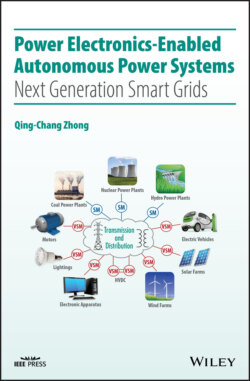Читать книгу Power Electronics-Enabled Autonomous Power Systems - Qing-Chang Zhong - Страница 27
2.3 SYNDEM Legal Equality – Homogenizing Heterogeneous Players as Virtual Synchronous Machines (VSM)
ОглавлениеFigure 2.3 illustrates the approximate electricity consumption in the US, according to the US Electric Power Research Institute. Although there are many different loads, there are four main load types: motors that consume over 50% of electricity, internet devices that consume over 10% of electricity, lighting devices that consume about 20%, and other loads that consume the remaining 20% of electricity. It is well known that the adoption of variable‐speed motor drives, which are equipped with power electronic rectifiers to convert AC electricity into DC electricity at the front‐end, is able to significantly improve the efficiency of motor applications (Bose 2009). Hence, the 50% of electricity consumed by motors could actually be consumed by power electronic rectifiers. Internet devices consume DC electricity so the 10% of electricity consumed by internet devices is consumed by power electronic rectifiers as well. As to lighting devices, there is a clear trend in the lighting market to adopt LED lights, which also include power electronic rectifiers at the front end. Hence, in the future, the majority of electricity will be consumed by rectifiers, whatever the end function is.
Figure 2.3 Approximate electricity consumption in the US.
On the supply side, most DERs are connected to the grid through power electronic inverters. For example, wind turbines generate more electricity at variable speeds, which means the electricity generated is not compatible with the grid and power electronic converters are needed to control the generation and interaction with the grid. Solar panels generate DC electricity, which needs to be converted into AC electricity to make it compatible with the grid as well. Similarly, electric vehicles and energy storage systems also require power electronic converters to interact with the grid.
In transmission and distribution networks, more and more power electronic converters, such as HVDC (high‐voltage DC) links (Arrillaga 2008) and FACTS (flexible AC transmission systems) devices (Hingorani and Gyugyi 1999), are being added to electronically, rather than mechanically, control future power systems (Hingorani 1988) in order to reduce power losses and improve controllability. The US Department of Energy is developing a roadmap to strategically adopt solid state power substations (SSPS) to provide enhanced capabilities and support the evolution of the grid (Taylor et al. 2017).
Figure 2.4 A two‐port virtual synchronous machine (VSM).
Putting all the above together, future power systems will be power electronics based, instead of electric machines based, with a huge number of relatively small and non‐synchronous players at the supply side, inside the network, and at the demand side. Although these players are heterogeneous, they are all integrated with the transmission and distribution network through power electronic converters that convert electricity between AC and DC. If all these power electronic converters could be controlled to behave in the same way, then millions of heterogeneous players could be homogenized and equalized (in the sense of per unit, i.e. in proportion to the capacity), achieving legal equality. Even better, if these power electronic converters could be controlled to behave like synchronous machines, then they would possess the inherent synchronization mechanism of synchronous machines as well. Such converters are called virtual synchronous machines (VSMs) (Zhong 2016b) or cyber synchronous machines (CSMs) as coined in (Zhong 2017e).
A VSM is a DC/AC converter that mimics synchronous machines with a built‐in energy storage unit connected on the DC bus, as illustrated in Figure 2.4 or on an additional port, as illustrated in Figure 19.1. The capacity of the energy storage unit can be large or small, depending on the magnitude and length of the power imbalance between the DC bus and the AC bus to be handled. For some applications, it is enough just to use the capacitors on the DC bus without adding an extra energy storage unit. The electricity can flow from the AC side to the DC side as a rectifier or, vice versa, as an inverter.
It is worth highlighting that operating power electronic converters as VSMs should not stop at the stage of simply mimicking conventional SMs but should advance to transcend conventional SMs. Power electronic converters can respond much faster than conventional SMs and possess much better controllability, which makes it possible for a VSM to transcend conventional SMs. This will be described in detail in later chapters.
